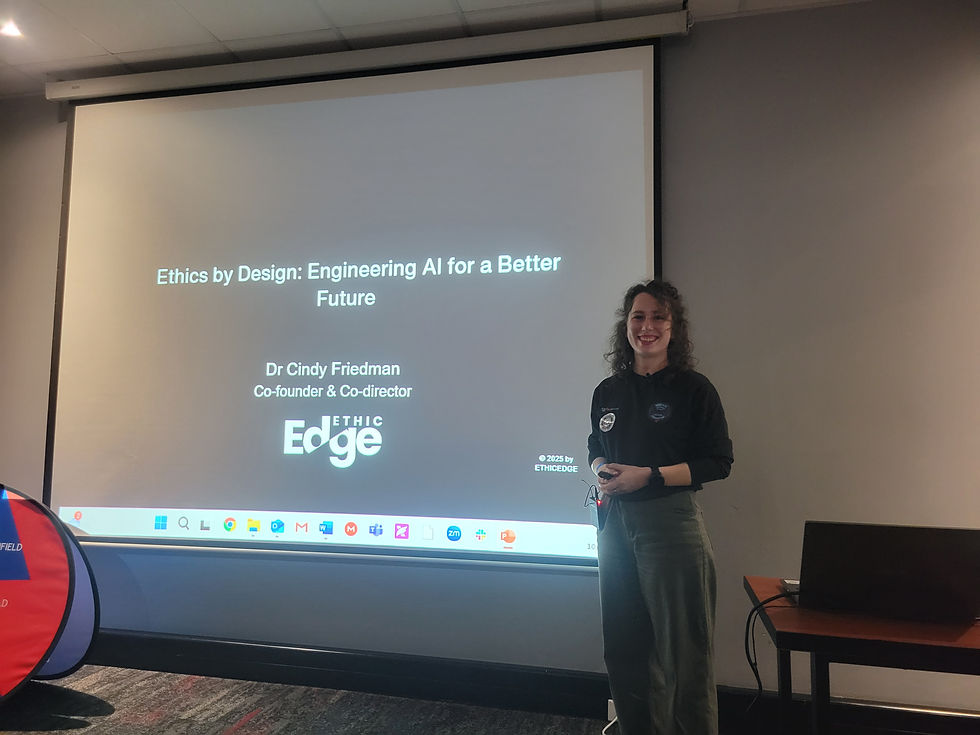Connecting Academia and Industry: A 5-Step Path to Ethical AI
- EthicEdge

- Oct 13
- 4 min read
On 11 October 2025, Dr Cindy Friedman, co-founder and co-director of EthicEdge, gave a presentation at the Data & AI Community Day Durban. The event brought together an incredible mix of researchers, professionals, and innovators who are all actively shaping the future of artificial intelligence in South Africa. Durban has a thriving AI scene and we, at EthicEdge, are so grateful to be a part of this growing and collaborative community.
Diverse audience and rich conversations
One of the most rewarding aspects of the day was the diversity of the audience. The room was filled with people from all walks of life: data scientists, software engineers, ethicists, business leaders, students, and even a few policy enthusiasts. This mix made the discussion dynamic and enlightening. As much as we attended the event to share our own experiences and insights, we also walked away with new perspectives and questions to explore.
It’s moments like these that highlight why interdisciplinary collaboration is so vital in AI. Ethical AI isn’t just a technical problem, it’s also a social, cultural, and economic challenge. Hearing how professionals from different sectors think about these issues left us with a deeper appreciation for the complexity of the field, and the importance of building bridges across disciplines.
Proactive AI Ethics and the Collingridge Dilemma
Dr Cindy’s presentation was titled “Ethics by Design: Engineering AI for a Better Future”. She began by introducing the idea of proactive ethics: taking ethical considerations into account early in the design and development of AI systems, rather than reacting to problems after they’ve caused harm. This approach helps organisations avoid not only moral pitfalls but also the financial and reputational damage that can arise from ethical oversights.
However, proactive ethics is easier said than done. She discussed the Collingridge Dilemma, a well-known problem in technology ethics. It describes how, early in a technology’s development, we have the most power to shape it, but the least understanding of its impacts. Later on, when the effects are clearer, it becomes much harder to make changes because the technology is already embedded in systems, economies, and daily life. You can think of this as a type of “wet cement” problem: Imagine pouring cement for a sidewalk. In the first few minutes, you can easily smooth it, write your name, or make changes. But wait an hour, and it’s set in stone—literally. Technologies are a bit like that. When they’re new, they’re flexible but unclear. Later, they’re rigid, but by then, you finally know what the cracks are. Think about social media algorithms, initially created to improve engagement on online platforms. At the time, we couldn’t foresee the issues that would arise with misinformation and radicalisation. However, now widely deployed, it is difficult and costly to change these algorithms.
Introducing the EthicEdge 5-Step Design Cycle
At EthicEdge, we’re passionate about helping organisations avoid these kinds of “wet-cement” problems through our unique 5-step cycle towards ethical AI design. This is a practical framework that integrates ethical thinking into every stage of AI development.
By embedding ethics early and iteratively, businesses can build AI that is not only compliant with regulations but also trustworthy and sustainable in the long term. In a world where consumers and partners increasingly care about responsible technology, ethical design has become a key driver of competitive advantage.
Our 5-step design cycle guides organisations through:
Identifying stakeholders: who are you designing for? Who will be affected?
Designing for privacy: designing for privacy principles, with impetus on relational privacy
Designing for dignity: focusing not just on human dignity approaches, but also environmental dignity
Technomoral future-making: considering the kind of future you want your AI technology to shape, while also anticipating how it could be misused
Closing the loop through iteration: establishing feedback channels and making ethical evaluation an ongoing, standard practice.
This approach ensures that ethics is not just a checkbox, but a living, iterative process embedded into the design and deployment of AI systems. This cycle helps organisations innovate responsibly while avoiding costly mistakes and reputational risks.
Recognition and Gratitude
To our delight, Cindy’s presentation was incredibly well received, as her talk was given an honourable mention. This recognition means a lot to the EthicEdge team. We’ve been working hard to bridge the gap between academia and industry by translating rigorous ethical theory into tools and processes that real-world businesses can use. Receiving such positive feedback from an audience that included both scholars and practitioners tells us that our message is resonating and that our vision of advancing ethical AI is shared.
Looking Ahead
The Durban AI community is growing fast, and the energy at the event makes us optimistic about the future. It’s clear that South Africa is not just following global AI trends but actively shaping them, with a focus on innovation that is both ambitious and values-driven.
As we continue to develop new tools and partnerships, our mission remains the same: to ensure that AI systems are designed and deployed ethically, avoiding the mistakes of the past and unlocking their full potential to do good.
We are grateful to the organisers and to everyone who attended, asked thoughtful questions, and shared ideas. Events like the Data & AI Community Day remind us that ethical AI isn’t just a technical conversation; it’s a community effort. We’re proud to be part of a community that’s leading with both intelligence and integrity.





Comments